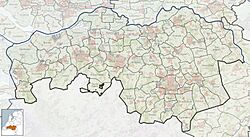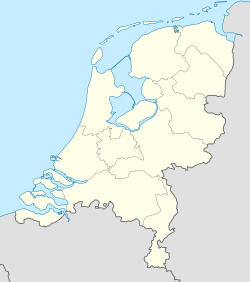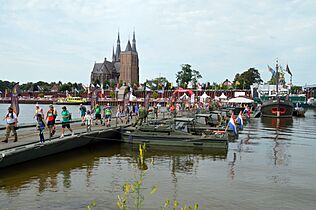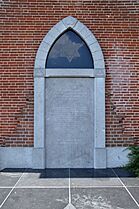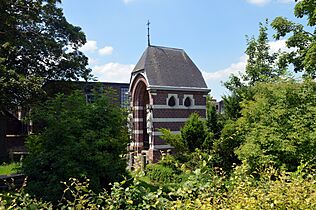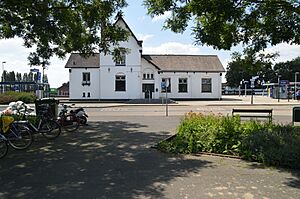Cuijk facts for kids
Quick facts for kids
Cuijk
|
|
|---|---|
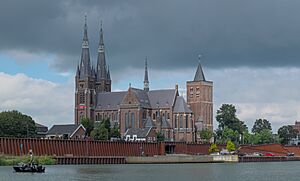
St. Martin's Church dominates the skyline on the Meuse
|
|
| Country | Netherlands |
| Province | North Brabant |
| Municipality | Land van Cuijk |
| Area | |
| • Total | 9.55 km2 (3.69 sq mi) |
| Elevation | 10 m (30 ft) |
| Population
(2021)
|
|
| • Total | 18,375 |
| • Density | 1,924.1/km2 (4,983.4/sq mi) |
| Time zone | UTC+1 (CET) |
| • Summer (DST) | UTC+2 (CEST) |
| Postal code |
5431
|
| Dialing code | 0485 |
Cuijk (pronounced Koo-ick; in local dialect: Kuuk) is a town in the northeastern part of the province of North Brabant, Netherlands. It is located on the west bank of the Meuse river, about 13 kilometers south of Nijmegen. Cuijk was once a Roman settlement.
As of 2020, Cuijk had about 18,170 people living there. It used to be the main town of its own municipality. However, on January 1, 2022, it became part of a larger municipality called Land van Cuijk.
Contents
What's in a Name?
The name Cuijk probably comes from an old Celtic word, Keukja. This word means "curve" or "bend." It refers to a bend in the Meuse river that is close to Cuijk. The Romans later changed Keukja to Ceuclum, which then became the Dutch name Cuijk.
A Look Back in Time
Early Days
Long before the Romans arrived, people already lived in the Cuijk area. We know about some of their Celtic culture through things found by archaeologists. For example, we know how they buried their dead. These early people raised cattle and farmed the land in simple ways. They lived in large huts or barns made of wood.
In the early 1900s, a settlement from around 700 BC was found near Haps. This is a town close to Cuijk. Other old remains were found in Cuijk itself. In 1844, many round burial mounds from the Bronze Age were discovered. These mounds contained urns with human ashes, showing they belonged to the Urnfield culture. Similar finds were made in 1825.
Roman Times: Ceuclum
Around 50 BC, Julius Caesar conquered Gaul. This brought Roman influence all the way to the Rhine river. The Rhine was protected by a line of forts called the limes. These forts were connected by roads.
One important Roman road led south from the limes. It went through Cuijk to Nijmegen and Tongeren. In the 20th century, many parts of this road were found near Cuijk. The town of Ceuclum and this road are even shown on an old Roman map called the Peutinger map. In the late 300s, the Romans built a bridge over the Meuse river at Cuijk. Parts of this bridge were found in 1992.
Foundations of a Roman fort (called a castellum) were found near St Martin's church in 1937, 1939, and 1949. Other discoveries include parts of Roman temples and a bath house. Pottery from later periods shows that people continued to live in Cuijk even after the Romans left.
Medieval Cuijk
The Lords of Cuijk were important rulers starting in the 11th century. They created the Heerlijkheid Cuijk, which was like their own small territory. They tried to stay independent from bigger counties and duchies nearby. Around 1133, Cuijk castle was destroyed. Because of this, the main center of their power moved to Grave.
Jan I van Cuijk (1230-1308) was a very important lord. He helped bring Cuijk under the influence of the Duchy of Brabant. Even though the lord lived in Grave, the main meetings and highest court for the Heerlijkheid Cuijk still happened in Cuijk.
Wars and Changes
During the Eighty Years' War (1568-1648), Grave was captured by the Spanish in 1586. The Dutch Republic took it back in 1602. This made Cuijk's situation uncertain until the war ended in 1648. After the war, Cuijk became part of the Dutch Republic. This meant that the mostly Catholic people living there had limits on practicing their religion.
In 1712, a big fire destroyed part of Cuijk. In 1795, Catholics were finally allowed to use their parish church again. The Protestant church was built in 1809.
The 1800s
The Meuse river often flooded the area around Cuijk. Big floods happened in 1820, 1861, 1880, and 1926. These floods made the town quite isolated for parts of the year. In 1883, the Nijmegen–Venlo railway opened. Cuijk got its own railway station, which connected it reliably to the rest of the country. In the same year, it also got an official post office.
Growing Industries
Most people in Cuijk worked in farming until very late in the 1800s. The wild lands around the town were farmed quite late. Cuijk was a center for farming, with many yearly markets for fabric, cattle, and other goods. It also had some factories. Around 1860, Johannes van Susteren made weighing scales and coffee grinders. Other companies made safes and fire hoses. There were also two breweries. People also made organs, church decorations, and candles.
In 1907, a dairy company called 'Lacto' was in Cuijk. In 1924, a company called Nutricia bought it. They started to focus on making food for children.
The tobacco industry was very important in Cuijk. Tobacco was grown nearby, and cigars were made in town. In 1859, a factory opened in Cuijk. This factory made 'Victor Hugo' cigars. In 1930, it employed many people, including 41 children.
Because there were many cattle, Cuijk also had several tanneries. These factories turned animal hides into leather. The most famous one was started by Regouin in 1838. By 1938, it was a Royal Leather and Belt Factory. It processed 20,000 hides each year. Many of these hides came from Java and could easily be brought to Cuijk by the Meuse river.
After World War II
Cuijk was freed on September 17, 1944. However, the other side of the Meuse river was still occupied until March 1945. This led to bombs and damage in Cuijk. After the war, Cuijk's location on the Meuse and its railway connections attracted many new companies. A large industrial area was built, and a harbor was dug near the village of Katwijk. The number of people living in Cuijk grew a lot, from 5,645 in 1950 to 15,300 in 1975.
Cool Places to See
- St Martin's Church: This church was built between 1911 and 1913. It is designed in the Gothic Revival architecture style.
- Old Church Tower: This tower is from the original Gothic St Martin's church, built in 1480. Today, it is home to Museum Ceuclum.
- Protestant Church: Located on the corner of Markt and Grotestraat, this small church was built in 1809. It has a neo-classical design.
- Jewish Monument: Built in 1985, this monument includes the back wall of Cuijk's old Synagogue.
- Former Regouin Tannery: You can find this old leather factory at Grotestraat 3.
- Former Cigar Factory Kansas: Located at Kerkstraat 7, this old factory is now a café.
- Windmill Jan van Cuijk: This windmill also used to grind bark for the tanneries.
- Fabrikantenwoning: At Stationsstraat 8, this house was built for the Regouin tannery family.
- Meuse Boulevard: Built around 2007, this area helps connect Cuijk with the Meuse river. From here, you can see parts of the Mookerheide and the Reichswald on the other side of the river.
Gallery
Museum
- Museum Ceuclum: This museum is located in the old tower of St Martin's church. It tells the history of Cuijk.
Nature Around Cuijk
Cuijk is right on the Meuse river. Just south of the town is a nature reserve called Zevenhutten. It covers 85 hectares and is owned by Brabants Landschap, a nature conservation group.
Getting Around
The nearby A73 motorway is the main road connection for Cuijk. Cuijk railway station is popular for people who travel to Nijmegen for work or school. A ferry service, called the Spes Mea, crosses the Meuse river between Cuijk and Middelaar, connecting to Limburg.
The Meuse harbor is important for transporting large amounts of goods. It also has a special terminal for shipping containers.
Sister Cities
Cuijk has friendly connections with these towns:
 Maldon, United Kingdom
Maldon, United Kingdom Lalinde, France
Lalinde, France Přerov, Czechia
Přerov, Czechia


